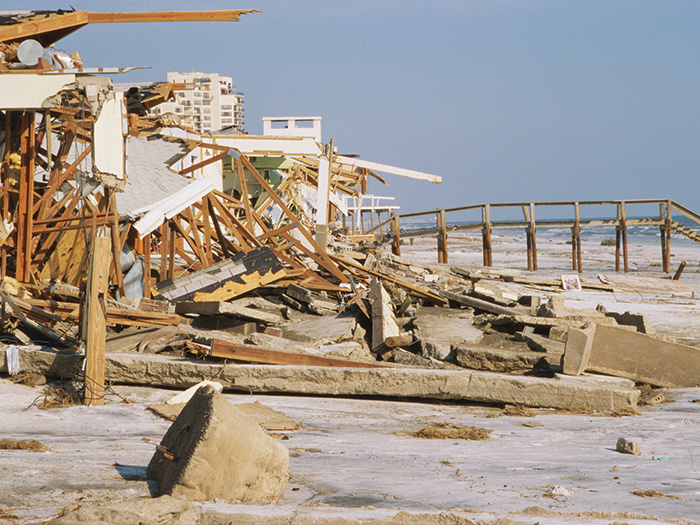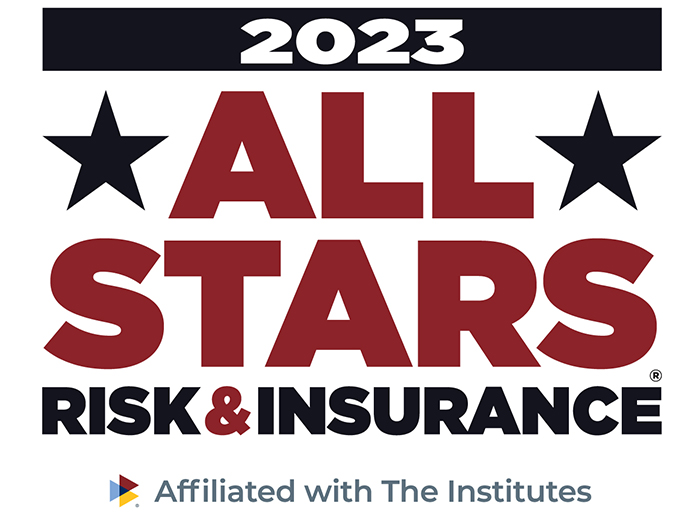From CAT 5 to Secondary Perils, How Insurance Is Battling Climate Change from an Underwriting and Investment Perspective

Insurance companies have always analyzed the frequency and severity of weather events. However, when it comes to climate change, the industry has had to modify the equations being used in its underwriting and actuary evaluations.
Alison Nisonger, head of property underwriting Global US, Swiss Re, said the industry has been challenged in recent years with a large uptick in the frequency and severity of catastrophe events.
For example, prior to 2017, wildfire wasn’t a topic for the industry and then two unprecedented events, each causing more than $10 billion is losses, occurred in 2017 and 2018 after several years of drought in California.
“Now, we see wildfire losses on a yearly basis and not only just in California but also arising in other states such as Oregon, Colorado, New Mexico, etc.,” Nisonger said.
Hurricane frequency has also increased in recent years, and the industry is seeing different types of losses arising from these events.
Nisonger noted that with rising temperatures, scientists expect to see an increase in the rainfall induced from hurricanes which will shift losses from wind to flood damage as seen in Hurricane Harvey in Texas and Hurricane Ida in the northeast.
“Outside a shift in frequency and severity of events, there is also a recognition that climate change directly impacts insurers/reinsurers,” Nisonger said.
Consumers, shareholders, and regulatory bodies want to understand how the insurance industry is addressing climate change in its portfolios, not just on an underwriting and risk analysis standpoint but also in terms of its investments and its own carbon footprint.
“Today we are looking at mitigating this risk from all angles of our business: from the risks we write, carbon we emit, to the companies we invest in,” Nisonger said. Thus, the industry really is tackling climate change from multiple dimensions.
“Rather than relying on historical data to model out future trends, insurers have increasingly had to develop predictive modeling based on projected assumptions,” said Helen Eichmann, senior vice president, Allied World Environmental Division.
“At Allied World, we talk about underwriting ‘looking through the windshield’ rather than the rear-view mirror.”
In Eichmann’s view, the driving force behind focusing on climate change issues is the desire for corporate sustainability, meaning a firm’s ability to remain a viable enterprise and also to contribute to a sustainable economy overall.
“Climate change is and will continue to pose challenges to our customers and to our own business. On a very fundamental level firms must navigate the challenges posed by climate change to be successful in the long term,” Eichmann said.
“Companies who keep the blinders on may not endure.”
Areas of Climate Change Concerns
The insurance industry breaks out natural disasters into critical CAT (hurricane, earthquake, and European winter storms) and secondary perils, such as wildfires, winter storms, flooding and tornado/hail.
For a long time, there has been a lot of focus put on critical CAT and subsequent models to assess these perils. However, as Nisonger pointed out, recently secondary perils have become a larger portion of catastrophe losses, making up over 60 to 70% of insured losses in 2020 and 2021, per the Swiss Re Institute.
“The challenge is secondary perils are not modelled as well and thus the industry is really only at its infancy in understanding how to properly assess, quantify and make portfolio steering decisions based on these perils,” Nisonger said.
In fact, 2021 was the first year that two secondary peril events generated losses over USD $10 billion with the winter storms in the U.S./Texas and the flooding in Europe.
“It’s clear that getting the impact from secondary perils right will be critical in the sustainability of our industry and battling climate change,” Nisonger said.
Eichmann pointed to additional climate change issues that intersect with the insurance industry, including the insurer’s investment portfolio, the impact of climate change on customers and the impact of climate change on an insurance company’s direct operations.
Consequently, many in the industry are starting to consider how climate change-related matters inform investment decisions. They are also looking into marrying insurance products with risk mitigation services that can help control losses.
Company Efforts
Allied World recognizes that more information and study is needed to understand climate change risks in a comprehensive way. For close to 10 years, Allied World has partnered with the Natural Wildlife Federation (NWF), one of America’s leading conservation organizations, to examine these issues.
In addition to partnering with NWF, Allied World offers policyholders an array of risk management resources which they can access to help them identify, evaluate, and respond to risks that are heightened by climate change, such as wildfire, flooding, extreme heat and others.
At Swiss Re, one big area of focus is product development, where the company looks to develop unique insurance covers that help clients manage the risks associated with a changing climate.
According to Cole Mayer, senior structurer, Swiss Re Corporate Solutions, one example of this is parametric hail. With this product, Swiss Re uses a physical metric, in this case hail size, to trigger a policy. The use of this metric allows the insurer to pay very quickly (within days of the event) and provide very broad, flexible coverage.
It also allows industry to protect energy resources that are themselves viewed as renewable.
“One area where we are looking to deploy this approach is with solar projects,” Mayer said.
“These solar sites are very hail prone, and severe hail events can significantly hamper production for a long period of time (particularly when supply chain disruptions are delaying the production and shipment of new panels).
“Our parametric cover can not only help existing projects better manage the risk, but can also help supplement the necessary insurance capacity to allow a project to get off the ground (which increases the number of solar facilities and helps move us toward more greener power production).”
Vertically integrating catastrophe and climate modeling expertise into all levels of an MGA – from its view of an individual risk through to portfolio level exposure is the way Delos Insurance addresses climate change exposures with its clients.
The company does this by marrying its expertise with data from Delos’s wildfire models to aggregate and analyze exposure and concentration to drive profitability, according to Kevin Stein, the company’ CEO and founder.
Delos has determined that out of the approximately six million homes across 13 states that struggle to find insurance because of wildfire risk, only around half of them are actually exposed to significant hazard.
“Delos has not insured a home yet that has burned,” Stein said.
Client Concerns
When the Swiss Re team talks with clients, three main concerns come up with respect to climate change. The first is the impact on the traditional insurance market and available capacity.
“Corporates and public entities have seen larger deductibles and tighter coverage terms as the natural catastrophe insurance market has hardened (which was and is necessary to maintain a sustainable insurance market),” Mayer said.
“As our clients retain more risk, they are looking for long-term sustainable ways to address this increased risk.”
The second concern is how climate change affects their increasingly complex business models; Swiss Re has seen how various global events that wreak havoc on a supply chain, and many suppliers and customers are in heavily natural catastrophe exposed areas.
“How our clients manage their ‘contingent’ natural catastrophe exposure is a huge consideration for them,” Mayer said.
Finally, clients also are thinking about how they themselves can help move the conversation around climate change, and the concrete steps society needs to take to mitigate it.
According to Stein, with the dramatic increase in the number of fires and the ensuing scale of destruction, there are a lot of folks in California who weren’t in a fire region in the past, but who now are.
“They didn’t move into a disaster zone, a disaster zone moved into them,” Stein said.
“Compounding the problem is that wildfire models that insurers had been using are unable to keep up with the changing peril, causing many insurers to pull out of any market they suspect may be potentially exposed,” Stein said.
“This leaves many people living in wildfire-stressed areas who simply cannot find reasonably priced homeowners’ insurance, if they can find insurance at all,” Stein said.
Continuous Evolution
Insurance companies have helped shape societal behavior in the past, for example in the areas of fire safety, worker safety, driving safety and others.
That’s why Eichmann believes the insurance industry’s focus on climate change will increasingly lead to specific underwriting and pricing mechanisms to help account for the industry’s heightened exposures, accompanied by additional resources to customers on how they can mitigate them.
Craig Poulton, CEO, Poulton Associates, LLC, owner of CATcoverage.com, which administers the Natural Catastrophe Insurance Program, believes that significant strides will be made in technologies that will allow greater predictability as to geographic areas that will be impacted by climate change.
“Additionally, great progress will be made in granular analysis of risk characteristics, especially geo-spacial risk characteristics,” Poulton said.
“These new technologies will eventually be adopted by and implemented by insurers across the globe.” &











